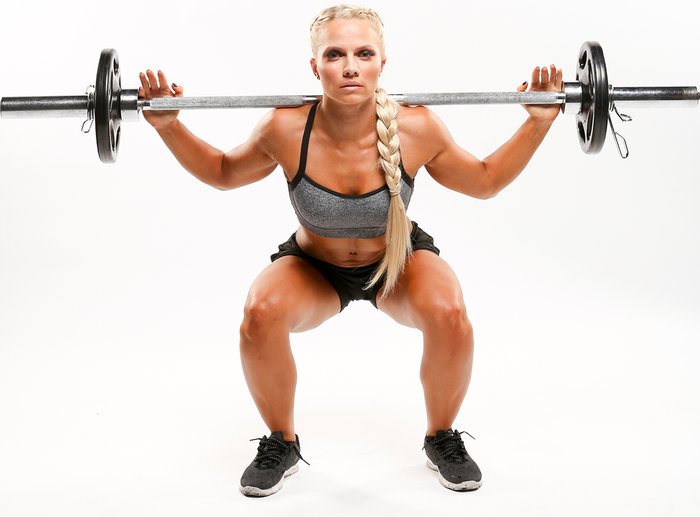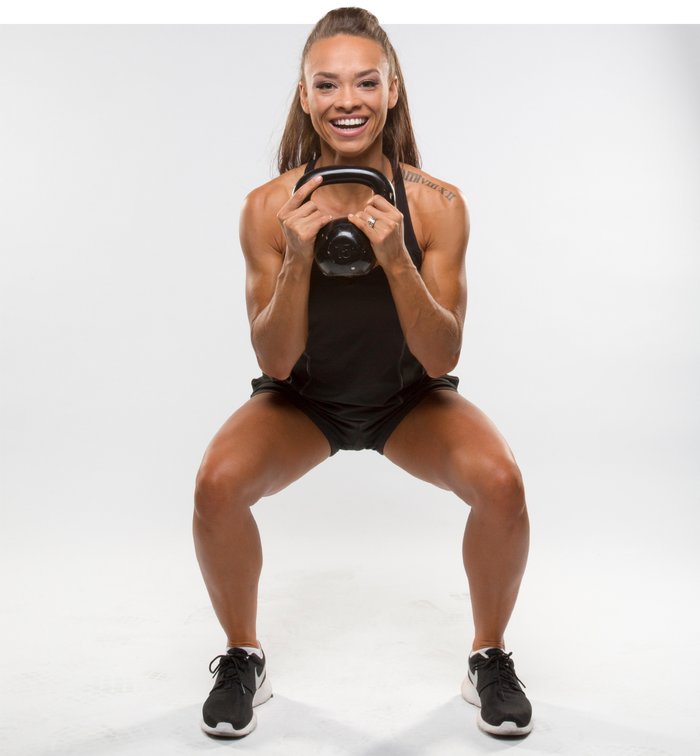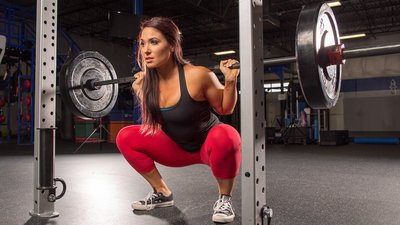Declaring that one lift is so important every woman should do it is bold. Not only does the lift have to provide incredible benefits, it also has to be scalable to different populations and different training settings. It has to be able to help women achieve any goal, from fat loss to muscle gain to being better at sports to feeling better in life to...you name it. It's a lift that has to make women feel strong and empowered, while also giving them plenty of room for growth.
What lift could meet all those standards? It's the squat, of course!
Now, I'm not necessarily talking about the barbell back squat, but rather, practicing and improving the squatting movement. The specific variation each woman does depends on her mobility, biomechanics, and the equipment available to her.
And while bodyweight squats are great, learning to squat with weight using the progression I outline here can make you a better squatter than a steady diet of air squats, and stronger to boot.
What's So Special About Squatting?
The squat is important for everyone to do, because it's the ultimate functional exercise. If you just rolled your eyes, hear me out here. I know the word "functional" gets tossed around a lot, often to describe things that strike me as anything but functional (squatting on top of an exercise ball is not "functional" or building stability; it's just dangerous.) So let's break this term down.
What's more functional than being able to stand up? What's more functional than being able to get off of a chair, off of the toilet, or out of a car? The squat trains the movements we do every day. Sure, you can do all these things and never touch a barbell, but you'll do them more safely and efficiently if you're strong at the fundamental movement that drives them. Other movements that are more of a hip hinge or deadlift motion, like picking up kids, groceries, or heavy objects off the ground, can also benefit from being a good squatter.

Squatting is also a great leg builder. A proper squat with good range of motion is great for your quads, hamstrings, and glutes. Do it right, and it's good for your knees, your hips, and your posture. Train it frequently to improve your performance, and you'll reap the physique-building benefits from this exercise.
My favorite reason to program the squat, though? Squatting makes you head-to-toe strong like nothing else. Building strength is fun, empowering, and something every woman should experience. Going from a 10-pound goblet squat to dominating 60 pounds is exhilarating. Smoothly repping a bodyweight barbell back squat is just plain badass.
The Squat Progression Anyone Can Use
The barbell back squat isn't deemed the "king of exercises" for no reason. It's terrific for building strength, you can easily manipulate the loading, and it's a great challenge for your body and your mind. If you've ever done a brutal set of 20+ reps, you know exactly what I mean!
But not everyone can properly, safely, or comfortably perform a barbell back squat. Some people have shoulder, back, hip, or knee issues that prevent them from executing the lift without pain or discomfort. Plenty of other people don't have access to barbells.
That's why squat variations are so useful! You can still train the movement properly, but you don't have to worry about pain or having any specific equipment. I have yet to train one person who can't perform at least one of these variations properly and without pain.
Goblet Squat to Box
This is a variation practically everyone can do. Have trouble squatting below parallel? No problem. Use a box that allows you to correctly squat to the lowest possible depth. As you progress over a few weeks, keep lowering the box until you're at least at or several inches below parallel.
The best thing about goblet squats? You can use pretty much anything as a weight. Sure, dumbbells and kettlebells allow you to use and track weight, but anything from a backpack to a sandbag to a rock can work here.
Seem too simple? Don't knock it till you try it—even if you're accustomed to barbell squats. If you use a challenging load, control the lowering portion of every rep (taking 2-3 seconds) and stay in the bottom position for a solid second before squatting back up, it can be quite challenging!
If you're already quite strong and feel comfortable with the squat, this variation still makes a great "finisher." Do 2-4 sets of 15-25 reps with the heaviest weight and lowest box you can handle. Your legs will be smoked.

Double Dumbbell or Kettlebell Squat
This variation is great because it forces you to keep a tall torso in order to keep the bells in the proper position against your chest. It's also a fantastic way to increase the weight of your squat without having to use a barbell. It doesn't take a lot of weight to make these feel difficult, too, making them a great option for women who just have a few weights at home.
If you've never squatted consistently, I don't recommend starting with this variation. Once you've gotten comfortable with the goblet squat to box variation, and have maxed out the amount of weight you use, then you can progress to using two front-racked weights.
Slow Eccentric Paused Back Squat
This is my favorite tweak on the classic barbell back squat. It's effective for ladies who want to make an exercise more challenging without piling lots of weight on the bar for every session. But it's also terrific for those interested in building max strength, because the pause at the bottom helps you get stronger in the "out of the hole" portion of the squat.
To perform this variation, load a barbell with about 50 percent of your max. If you don't know what that number is, err on the side of lightness at first, then add weight in future sessions. Lower yourself down for about 3-5 seconds, pause in the bottom for 1-2 seconds, then squat back up.
By slowing down the lowering (eccentric) phase, you have to focus on keeping your core tight and your form on point. The pause in the bottom position also makes the movement much more challenging. Expect to be humbled.
When in Doubt, Squat It Out
When and if you're ready, the barbell back squat is a great movement. But it's really only worth doing if you are going to do it well. These three variations will make you both a better squatter and a stronger squatter. You can ride them out for as long as you want, or do them as a progression toward back squats for reps. Either way, you'll see plenty of benefits.
Believe me: You can squat. You should squat. Don't fear it. Do it!

